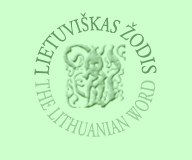Cultural life.
New York City and Pennsylvania's mining towns gave rise to the earliest
cultural endeavors. The first Lithuanian newspaper in the United States,
Gazieta Lietuviszka, was founded in New York in 1879 by Mykolas
Tvarauskas; it had 132 sub scribers but was discontinued in 1882 after
16 issues. Tvarauskas made a second attempt in 1884-85 with the weekly Unija
(Union), which he published in Lithuanian and Polish, hoping to appeal
to a larger readership; this venture lasted six months. The weekly Wienibe
Lietuwniku (Lithua-
nian Unity) began publication in Plymouth,
Pennsylvania, in 1886; it is still extant in Brooklyn, New York, as Vienybė
(Unity), although it has
undergone periodic changes in
editorial policy under diverse publishers
and editors. Jonas Sliupas, who had
collaborated with Tvarauskas previously, in 1885-89 brought out Lietuviszkasis
Balsas (The Lithuanian Voice), published in Brooklyn and then in
Shenandoah. During 1892-99 twelve newspapers came into being, of which
not one has survived. A number of newspapers of the early 20th century,
representing four main streams of thought, have endured to the present
day: the socialist Keleivis (The Traveler, since 1905) and Naujienos
(The News, 1914), the Catholic Draugas (The Friend, 1909) and Darbininkas
(The Worker, 1915), the liberal Sandara (Concord, 1918), and the
nationalist Dirva (The Field, 1916). (See Periodicals).
Translations into Lithuanian as well as original work, published by
individuals or newspapers, began to appear in 1880. Vienybė
published Simonas Daukantas' Lietuvos istorija (The History of
Lithuania, 1893-97); Garsas (The Sound) produced Bishop Motiejus
Valančius Žemaičių viskupystė (The Diocese of Samogitia,
1897); in the issues of
Dirvažinynas
were printed in 1898-1900 works of folklore and history. The Association
of Lithuanian Patriots had published a score of popular and scholarly
books by 1900. Altogether, about 200 publications in Lithuanian appeared
during 1885-1900, some of them in printings of 2,000-4,000 copies.
Lithuanian periodicals and books published
in the United States performed an invaluable service for the homeland
itself, where from 1864 to 1904 the printed word was forbidden by the
Russian authorities and had to be smuggled in as contraband from abroad.
A collection of Lithuanian books printed abroad during that time was
exhibited at the Paris World's Fair (1900), which included a Lithuanian
ethnographic section.
Apart from the field of letters, there was
lively activity in the performing arts as choirs, singing and music
societies, and dramatic circles were organized. Almost every parish had
a choir, whose performances were not restricted to church services, but
extended to non-religious functions as well. Of the choral groups the
first was the Milda men's chorus of Brooklyn (1894). Composer
Mikas Petrauskas was a leading proponent of choral groups and choral
singing. With the
choruses Birutė in Chicago (1907)
and Gabija in Boston (1924), both of which he had founded, he
staged a number of operettas of his own composition. The Pirmyn
chorus organized in Chicago (1909) produced over 40 operettas and
several operas. The first song festivals were held in Chicago and New
York in 1916, and later other communities followed this example. Amateur
dramatic groups were frequently established in conjunction with the
choruses. The Lithuanian Theatrical Society was founded in Chicago in
1892; its most successful production was a play depicting the Battle of
Tannenberg (1410), which had a four-year run in Chicago and other
Lithuanian communities. During
1892 1914 at least 15 dramatic and
musical groups were active (see Theater).
Text from the ENCYCLOPEDIA LITUANICA I-VI.
Boston, 1970-1978

